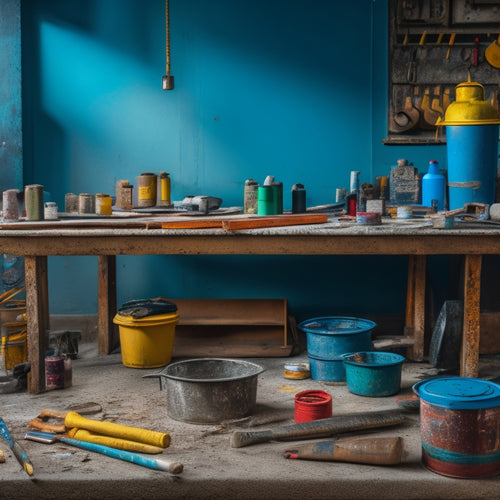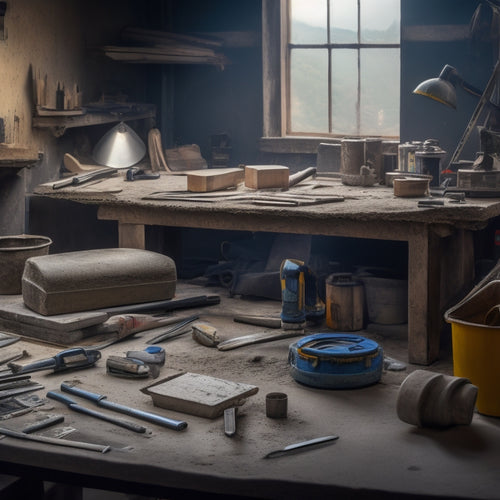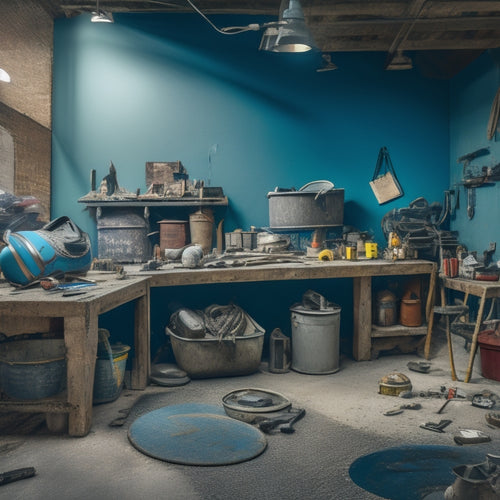
What Tools Do You Need to Seal Concrete Floors
Share
To seal a concrete floor, you'll need a range of specialized tools, including heavy-duty scrub brushes, floor grinders, and scarifiers for surface preparation, as well as concrete floor scraping tools, edge control options, and grinding pattern selection for precision finishing. Additionally, sealer application equipment like microfiber pads and foam brushes, sprayers and rollers, safety gear like respirators and protective clothing, and measuring and mixing tools will be essential. Finally, post-seal cleaning supplies will help you maintain your equipment and guarantee a successful project. With the right tools, you'll be ready to achieve a professional-grade finish.
Key Takeaways
• Essential cleaning equipment, such as a heavy-duty scrub brush and floor cleaning solution, is necessary for preparing the concrete floor.
• Surface preparation tools, including a floor grinder or scarifier, are required to remove existing coatings and open concrete pores.
• Concrete floor scraping tools, like a reliable scraper with rigid or flexible blades, are needed to remove old sealants and adhesives.
• Sealer application equipment, including microfiber pads, foam brushes, and sprayers, must be selected based on the type of sealer being used.
• Safety gear and protective wear, such as safety goggles, heavy gloves, and respirators, are crucial for protecting yourself during the sealing process.
Essential Cleaning Equipment
You'll need three essential cleaning tools to effectively remove dirt, grime, and old sealers from your concrete floor before applying a new sealant.
First, a heavy-duty scrub brush is necessary for agitating and loosening stubborn dirt and grime. This brush should have stiff bristles and a long handle to provide maximum leverage.
In addition, you'll require a floor cleaning solution that's specifically designed for concrete floors. This solution should be able to effectively break down dirt and grime without damaging the concrete. Look for a solution that's pH-neutral and biodegradable to guarantee safe use.
Finally, a wet vacuum or mop is necessary for removing the dirt and cleaning solution from the floor. This will help prevent dirt and debris from being re-deposited onto the floor during the cleaning process.
Necessary Surface Preparation Tools
After cleaning the concrete floor, it's time to prepare the surface for sealing by using specialized tools that guarantee a strong bond between the concrete and the sealant.
You'll need to assess the substrate's condition to determine the best surface preparation techniques for your specific project. This involves using substrate assessment methods to identify any imperfections, cracks, or weaknesses that may affect the sealant's adhesion.
To achieve a smooth, even surface, you'll need to use tools such as a floor grinder or a scarifier to remove any existing coatings, dirt, or debris. These tools will also help to open up the concrete's pores, allowing the sealant to penetrate more effectively.
Additionally, you may need to use a vacuum or a blower to remove any dust or debris generated during the preparation process.
Concrete Floor Scraping Tools
Frequently, concrete floor scraping tools are employed to remove old, worn-out sealants, adhesives, or other substances that may interfere with the new sealant's adhesion.
You'll need a reliable scraper to effectively remove these substances, guaranteeing a strong bond between the concrete and the new sealant. When selecting a scraper, consider the type of substance you're removing, as well as the floor's surface condition. For instance, a putty knife or a floor scraper with a rigid blade is ideal for removing old adhesives, while a scraper with a flexible blade is better suited for scraping off sealants.
To optimize your scraping techniques, maintain a consistent angle of attack, applying moderate to heavy pressure. This will help prevent gouging the concrete surface.
Additionally, perform regular scraper maintenance to guarantee the blade remains sharp and free of debris. Dull blades can lead to ineffective scraping and increased labor time.
Floor Edger and Grinder Options
When you're working on sealing concrete floors, you'll need to take into account the right floor edger and grinder options to get the job done efficiently.
You'll want to think about edge control options, such as adjustable edge guides or pivoting heads, to guarantee a precise finish.
Additionally, you'll need to decide on a grinding pattern that suits your project's specific needs, whether that's an aggressive removal of old coatings or a fine polish.
Edge Control Options
Mastering edge control is essential, as it allows you to achieve a seamless blend between the sealed floor and adjacent surfaces. This is where floor edgers and grinders come into play.
Edge treatment methods and edge sealing techniques are critical in ensuring a professional finish. To get it right, you'll need the right tools for the job.
When it comes to edge control, you have several options to evaluate:
-
Floor edgers: These are specialized tools designed to work on edges, corners, and tight spaces where larger grinders can't reach. They're perfect for creating a clean, defined edge.
-
Angle grinders with edge wheels: These are versatile tools that can be used for both grinding and edging. They're ideal for removing old coatings, roughening the surface, and creating a smooth edge.
-
Hand grinders with edge guides: These are handheld tools that provide more control and precision when working on edges and corners. They're great for detail work and creating a seamless blend between the sealed floor and adjacent surfaces.
Grinding Patterns Matter
By selecting the right grinding pattern, you can effectively remove old coatings, roughen the surface, and achieve a smooth finish that's essential for a successful seal. Your grinding technique and pattern selection will greatly impact the final result.
For instance, a circular pattern is ideal for removing old coatings and roughening the surface, while a linear pattern is better suited for achieving a high-gloss finish. Additionally, the direction of your grinding pattern matters. Grinding with the direction of the concrete's natural texture can help reduce scratches and swirl marks. Conversely, grinding against the texture can create unwanted imperfections.
When working with a floor edger, you'll need to adjust your grinding pattern to accommodate the machine's design. For example, some edgers are designed for circular patterns, while others are better suited for linear patterns.
Sealer Application Equipment
You'll typically use a range of specialized tools to apply concrete sealer efficiently and effectively. The type of sealer you're working with and the specific application techniques you're using will influence the equipment you need. For instance, different sealer types may require distinct application tools to achieve the best results.
When it comes to applying concrete sealer, you'll need equipment that can handle the specific demands of your project. Here are some essential tools to take into account:
-
Microfiber pads or lambswool applicators for applying solvent-based or low-VOC sealers, which require a more even, controlled application.
-
Foam brushes or rollers for water-based sealers, which can be applied more liberally.
-
Squeegees or notched trowels for epoxy or polyurethane-based sealers, which require a higher level of precision and control.
Sprayers and Rollers Needed
In addition to the application tools mentioned earlier, you'll also need to reflect on the role of sprayers and rollers in efficiently covering large areas with your chosen concrete sealer.
When it comes to sprayers, you'll want to evaluate the type that best suits your project. There are three main sprayer types: handheld, backpack, and cart-style sprayers. Handheld sprayers are ideal for small to medium-sized areas, while backpack and cart-style sprayers are better suited for larger areas.
Rollers, on the other hand, are essential for achieving an even coat and preventing puddles from forming. You'll need to choose the right roller materials for your sealer, as some may leave behind fibers or marks. Microfiber rollers are a popular choice, as they provide a smooth finish and can be used with most sealers. You may also think about using foam rollers or lambswool rollers, depending on the specific requirements of your project.
Safety Gear and Protective Wear
As you prepare to seal your concrete floor, don't overlook the essential role of safety gear and protective wear in safeguarding your health and well-being. Sealing concrete floors can involve harsh chemicals, heavy equipment, and physical labor, making it vital to prioritize your safety.
To guarantee you're adequately protected, consider the following essential safety gear and protective wear:
-
Safety goggles: Protect your eyes from chemical splashes, debris, and other hazards with sturdy, chemical-resistant goggles.
-
Heavy gloves: Guard your hands against abrasive materials, sharp edges, and harsh chemicals with thick, durable gloves.
-
Breathable protective clothing: Wear long-sleeved shirts, long pants, and closed-toe shoes to prevent skin exposure to chemicals and minimize the risk of injury.
Measuring and Mixing Tools
Six essential measuring and mixing tools are required to accurately prepare the sealant for your concrete floor.
You'll need a digital scale to guarantee measuring accuracy, as even slight deviations can affect the sealant's performance.
A mixing bucket with a lid is necessary for combining the sealant components, and a mixing stick or paddle will help you achieve a uniform consistency.
For larger batches, a paint stirrer or mixing paddle with a drill attachment can be used, streamlining the mixing process.
To guarantee precise measurements, you'll also need measuring cups and spoons.
A calculator will come in handy when calculating the correct ratios and quantities.
Finally, a mixing guide or instructions specific to the sealant you're using will provide valuable guidance on mixing techniques and proportions.
Post-Seal Cleaning Supplies
You'll need a set of post-seal cleaning supplies to remove excess sealant, clean your tools, and maintain the appearance of your newly sealed concrete floor. These supplies are vital for effective post-seal maintenance, ensuring your floor looks its best and lasts longer.
Here are some essential cleaning agents and tools you'll need:
-
Solvent-based cleaning agents to dissolve and remove excess sealant from your tools and floor
-
Microfiber cloths or mop to clean the floor and absorb any remaining sealant
-
Tool cleaning brush to scrub and clean your tools, preventing sealant buildup and ensuring they're ready for the next project
Frequently Asked Questions
Can I Seal a Concrete Floor With Existing Cracks and Imperfections?
You can seal a concrete floor with existing cracks and imperfections, but first, you'll need to address those issues.
Crack repair is vital to prevent further damage and guarantee a successful seal.
Proper surface preparation is also important, so make certain to clean and profile the floor to create a strong bond between the concrete and sealant.
How Long Does It Take for the Sealer to Fully Cure and Dry?
You've successfully sealed your concrete floor, and now you're keen to know when it'll be fully cured and dry.
The cure time varies depending on the sealer type and environmental conditions.
On average, it takes 24 to 48 hours for the sealer to fully cure, and the drying process can take anywhere from a few hours to a few days.
Do I Need to Apply a Second Coat of Sealer to My Concrete Floor?
When you apply a sealer to your concrete floor, you're likely wondering if a second coat is necessary.
The answer depends on the sealer application benefits you're looking for. If you want enhanced protection, improved stain resistance, and a higher gloss finish, a second coat is a good idea.
However, if you're satisfied with the initial results, one coat might be sufficient.
Consider the manufacturer's instructions and your floor's specific needs to determine the best approach for your project.
Can I Use a Sealer on a Newly Poured Concrete Floor Immediately?
Don't be too keen to seal that freshly poured concrete floor just yet!
You're probably wondering, can I use a sealer on a newly poured concrete floor immediately? The answer is no, you shouldn't.
Allow the concrete to reach its recommended curing time, usually 28 days, to guarantee proper hydration and strength development.
Also, monitor moisture levels, as excess moisture can affect sealer adhesion and performance.
Wait patiently, and you'll be rewarded with a strong, durable, and well-sealed concrete floor.
Will a Concrete Sealer Make My Floor Slippery When Wet?
You're right to wonder if a concrete sealer will make your floor slippery when wet.
The answer lies in the type of sealer you choose and its impact on slip resistance. Some sealers can fill in the surface texture, reducing traction.
Look for sealers that maintain or even enhance the natural texture of your concrete, ensuring a safe walking surface even when wet.
Conclusion
As you prepare to seal your concrete floor, remember that having the right tools is key to a successful job.
It's like trying to bake a cake without the right ingredients - it just won't turn out right.
With the essential cleaning equipment, surface preparation tools, and sealer application equipment, you'll be well on your way to a beautifully sealed floor.
Take the time to gather all the necessary tools and you'll be enjoying your new floor in no time.
Related Posts
-

Essential Tools for Painting Concrete Walls
When painting concrete walls, you'll need a range of specialized tools to achieve a professional-looking finish. Star...
-

3 Best Hand Tools for DIY Concrete Construction
When tackling a DIY concrete construction project, you'll need three essential hand tools to achieve a professional-l...
-

What Tools Do You Need for Concrete Flooring
You'll need a thorough arsenal of specialized tools to achieve a high-quality, professional-looking concrete floor, i...


